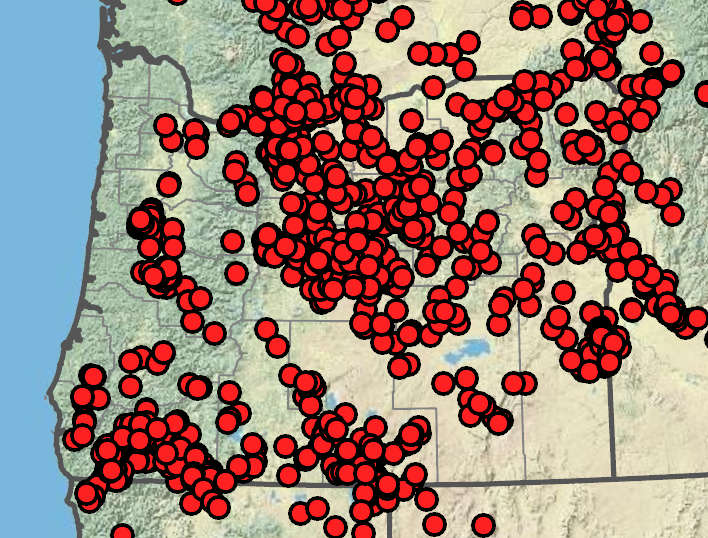Lomatium triternatum
(synonym of Lomatium packardiae)
broad-fruit lomatium, broad nineleaf lomatium, nineleaf lomatium, Packard's lomatium
slender, elongate taproots or irregularly thickened, elongate taproots with an elongate and slender upper portion 1–6 cm.
simple, 2–3-branched or multicipital;
basal leaf sheaths from previous years weathering into a sparse thatch of a few; loose fibers or chaffy scales at base of stem or pseudoscape, previous year’s peduncles sometimes persistent in thatch as gray stalks.
absent or 10–20 cm; pseudoscapes absent or < 1 cm, obscured by leaf sheaths and thatch.
biternate or 1–3-pinnate, glabrous, glabrate or sparsely puberulent or scaberulose along midnerves and margins, sparsely scabrous or pubescent below and glabrate or pubescent on midnerves above;
primary leaflets ternate or pinnate, 0–6 secondary leaflet pairs along each rachis;
laterals half to subequal to central primary in length;
secondaries pinnate; pinnatifid, ternate or entire;
tertiaries absent; entire; pinnatifid (2–3-lobed), ultimate apical lobes linear, narrowly elliptic, or narrowly oblong, 10–120 × 0.4–12 mm;
tips acute or acuminate, mucronulate or not.
0–2, similar to basal.
peduncles 1–6, 10–35 cm, glabrate or sparsely to moderately scaberulose or puberulent;
involucral bracts 0;
rays 3–25, 1.5–12 cm, glabrate, sparsely scaberulose, or puberulent;
involucel bractlets 0–12, linear or lanceolate, 1–6 × 0.1–0.4 mm, glabrous; entire;
margins narrowly scarious or not;
umbellets 10–70-flowered;
pedicels 2–8 mm, glabrous, glabrate, scaberulose on ridges.
petals ochroleucous or yellow;
anthers ochroleucous or yellow.
oblong, narrowly oblong, elliptic or obovate, 7–16 mm, glabrous, glabrate, or sparsely scaberulose or puberulent;
body 1.3–4 mm wide;
wings 0.7–3 mm; thin;
vittae 1 in intervals, 2 on commissure.
Lomatium triternatum
Diverse habitat types but most commonly on open slopes, meadows, rocky hillsides. Flowering Feb–Jul. 0–2600 m. BR, BW, Col, CR, ECas, Lava, Owy, Sisk, WV. CA, ID, NV, WA. north to British Columbia, northeast to Alberta, east to CO, southeast to AZ. Native.
Lomatium triternatum is a complex with many ecotypes and morphotypes. Numerous varieties have been named, and some have been delimited at the species level. The ecotypes that have been named include: 1) acaulescent or caulescent plants with pubescent, short narrow apical leaflets lobes (1–4 mm wide) [= L. packardiae]; 2) caulescent plants with short narrow apical leaflets and lobes (1–2 mm wide) that are variously pubescent [= L. tamanitchii; L. triternatum var. brevifolium]; 3) caulescent plants with broad, short leaflets (10–50 × 2–8 mm) [= L. anomalum]; 4) caulescent plants from the west side of the Cascades with very long and broad leaflets (50–120 × 1–12 mm) [= L. triternatum var. macrocarpum]; 5) plants with strictly ternate lateral leaflets with lobes long and narrow (20–90 × 0.4–1.5 mm) and fruit wings (2–3 mm) equal to or wider than the body [= L. simplex]. All of these forms grade into each other imperceptibly, and often more than one form can be found on a herbarium sheet. Although Lesica and Kittlelson (2013) make a robust argument for the separation of L. anomalum from L. triternatum, the condition of the types of L. anomalum prevents the reliable assignment of this name to any of the named ecotypes of L. triternatum. The types are in a mature fruiting stage with dried and withered leaves. Additionally, the leaves are fragmented, and the length and width of the leaflet lobes cannot be determined. The name needs epitypification before it can be applied to forms in the remainder of the range of L. triternatum, regardless of how other workers have applied this name to specific morphological variants in the past.
Jason Alexander



